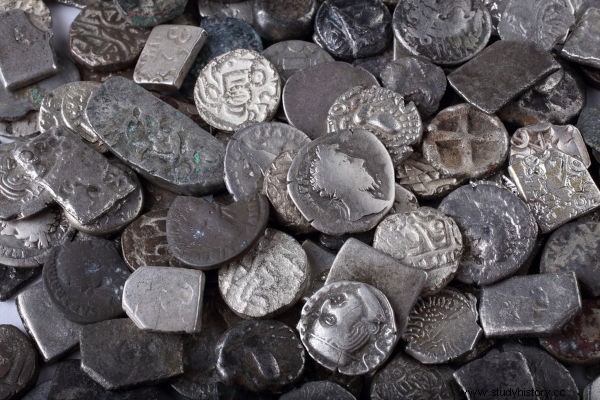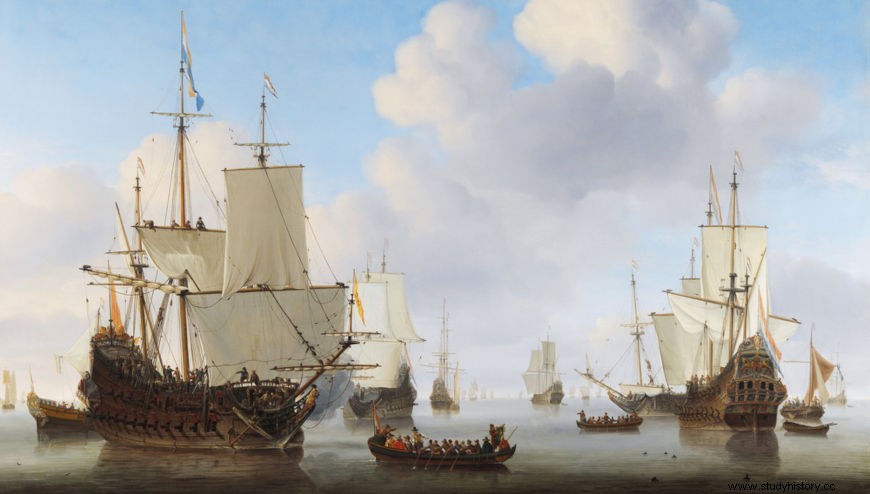
The mercantilism was the set of economic practices used by the absolutist nations of Europe during the Modern Age, specifically between the 15th and 18th centuries. In mercantilism, the objective was to guarantee the accumulation of wealth by obtaining precious metals and using them to reinforce the power of the monarch.
Among the characteristics of mercantilism, the the search for a favorable trade balance, metalism, protectionism, state intervention in the economy and the encouragement of manufacturing development. Mercantilism relied heavily on colonial exploitation and maritime trade.
See also: Economic liberalism — the defense of state non-intervention in the economy
Summary on mercantilism
-
Mercantilism was the set of economic practices that existed in Europe between the 15th and 18th centuries.
-
It is considered by historians as a moment of transition between feudalism and capitalism.
-
It was intended to ensure the enrichment of the kingdom and contribute to the strengthening of the monarch.
-
It had characteristics such as the search for a favorable trade balance, metalism, protectionism, state intervention in the economy and incentives for manufactures.
-
It was established with Absolutism and the Modern National State.
Video lesson on mercantilism
What is mercantilism?
Mercantilism is known for being a set of economic practices that existed during the Modern Age, especially between the 15th and 18th centuries. For historians, mercantilism was marked by economic practices of transition between the feudal mode of production and the capitalist mode of production .
The purpose of mercantilism was to ensure the prosperity of the kingdom through the accumulation of wealth, as well as to reassert the power of the king, who used possessions to strengthen his authority. The development of mercantilism contributed to the strengthening of the bourgeoisie and took place together with the process of formation of the Modern National States.
Characteristics of mercantilism
Mercantilism was a set of economic practices that aimed to ensure theenrichment of the State through the accumulation of wealth . In the context of the Modern Age, this accumulation would take place through the collection of precious metals, that is, gold and silver. Mercantilist practices aimed to prevent, as much as possible, this wealth from leaving the crown's coffers.
The prosperity of the State was also a way of guaranteeing the strengthening of royal power, a mechanism that was used to combat the privileges of the feudal nobility, a class in decline at the time. The privileged class in this scenario was the bourgeoisie, which saw in the strengthening of the king a way to prosper economically and to fight the influence of the nobility.
The obtaining wealth in mercantilism could give up various ways . The State could collect taxes from the population, sell public offices and titles of nobility, confiscate goods, cede commercial privileges to a certain group in exchange for financial compensation (monopolies), export goods, loot in the context of war, collect customs fees, carry out actions piracy etc.|1|
All these practices were used by European nations to achieve the much-desired favorable trade balance, that is, revenues and sales surpassing State expenditures and purchases. An extremely important event for the success of these economic practices among European nations was the colonialism .
Colonialism was fundamental to European states, as it allowed them to exploit numerous resources from their colonies and ship them to Europe. This also made it possible for these colonies to be transformed into compulsory consumers of their metropolises, due to commercial exclusivity.
The search for mercantilism to guarantee a trade balance at all costs ended up generating the adoption of protectionist policies by European states for their economies. Thus, they sought to discourage imports through customs duties, that is, taxes that were levied on goods brought in from other countries.
In addition, strict policies were established that defined who a nation could trade with and with whom he could not. Another way of combating imports of goods was to encourage them to be produced in their own territory. Thus, absolutist monarchs who adopted mercantilism encouraged the development of manufactures in their kingdoms.
We can see, therefore, that an important characteristic of mercantilism is the constant interference of the State in the economy, as a way of guaranteeing the entry of precious metals and the consequent enrichment of its kingdom.
When exports were not enough to guarantee the entry of precious metals in acceptable quantities, absolutist states resorted to other ways of obtaining money. In France, for example, the main taxes were levied on the peasant population , already weakened by its harsh living conditions.
These ways of obtaining wealth went beyond that, as they included practices of looting in conflicts and, in the English case, the encouragement of privateering, that is, piracy. England financed a number of privateers throughout the 16th and 17th centuries to plunder Spanish vessels leaving America laden with gold and silver. Absolutist states also confiscated goods from part of the population, as happened with Jews in Spain in the late 15th century.
In addition, the enforcement of trade monopolies it was a way for absolutist states to profit. In these monopolies, the exploitation of an economic activity was in charge of only one company, and a part of the profits had to be delivered to the crown. Furthermore, the absolutist states obliged their colonies to resort only to these monopolies to carry out transactions.
Finally, we can summarize the characteristics of mercantilism in the following topics:
-
Favourable balance of trade: defense of the idea that it was necessary to export more than to import.
-
Metalism: accumulation of precious metals in the vaults of the kingdom.
-
Protectionism: use of forms of protection of the economy, such as customs duties.
-
State Intervention: the State frequently intervened in the economy as a way of guaranteeing its commercial interests.
-
Incentive to manufactures: incentive to the development of manufactures as a way to protect the economy.
Also read: Colonial Pact — the practice of exclusivity of profits from colonial production to the metropolis
Origin of mercantilism
The origin of mercantilism is directly associated with the development of A bsolutism and to formation of Modern Nation States . This was the period of rise of the bourgeoisie, a class that prospered through commerce and that defended the end of the privileges of the feudal nobility. The bourgeoisie saw in the strengthening of the monarch a way of combating the privileges of this class, privileges deriving from feudalism.
Thus, gradually the idea of concentrating power in the hand of the monarch strengthened . The nobility, who wanted to keep part of their status, was forced to accept the new order that was being established, having to give up some of their privileges, such as the right to form private armed forces.
This centralization of power in the hands of the monarch consolidated the emergence of mercantilism, but also resulted in the emergence of Modern National States, that is, nations that had a complex bureaucracy apparatus, with power centralized. This bureaucracy helped the monarch in the process of public administration of the kingdom.

The military forces passed into the hands of the monarch and became became professionals, law and justice were unified, currency standardizations and, in some places, linguistics were imposed.
Modern Nation States sought to expand their territorial borders through maritime navigations. It is also noteworthy that the feudal mode of production lost strength and gave way to the consolidation of trade and the exploitation of resources from other places through colonialism.
Learn more: What is neocolonialism?
Types of mercantilism
Throughout the period of mercantilism, historians have identified different types of this practice. In other words, in certain periods, certain trends have established themselves as predominant in some European nations. Let's see what those subdivisions were.
→Metalistic mercantilism
Metalistic mercantilism was based on the accumulation of precious metals coming from the exploration of colonies . The extraction of gold and silver from the Spanish colonies in America was an emblematic case.
→ Commercial Mercantilism
Commercial mercantilism was based on the exploitation of colonies, but its focus was on trade r goods in colonies on logic of commercial exclusivism . The exploration of Brazil by Portugal and the realization of trade in India was the main example of this.
→ Industrial Mercantilism
Industrial mercantilism was based on incentive to manufacture building as a way of protecting the economy itself and preventing the entry of foreign goods. For this, it was necessary to secure colonies to supply the most important raw materials.
This model was proposed by a French economist named Jean-Baptiste Colbert and had a great influence on the reign of Louis XIV, making France the main example of this type of mercantilism.
Note
|1 | MICELI, Paul. Modern History. São Paulo:Context, 2020, p. 98.
